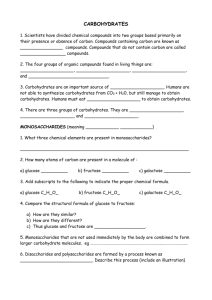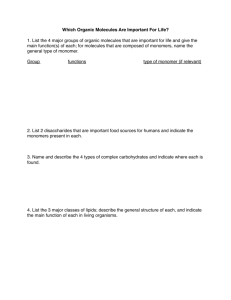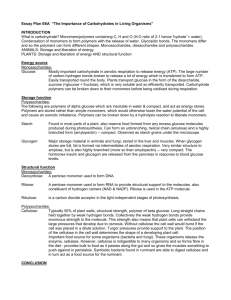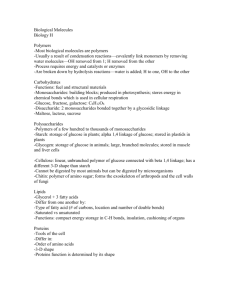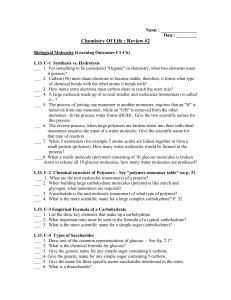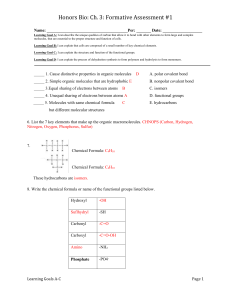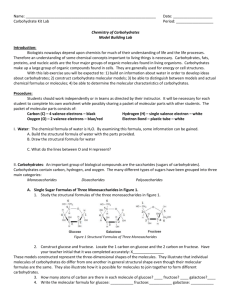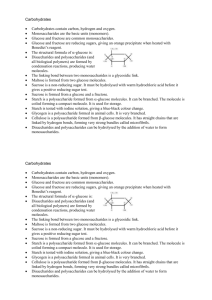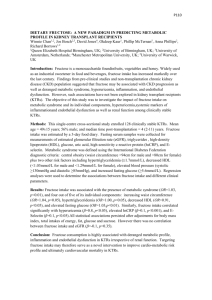Biology Study Guide 3 Carbohydrates Monosaccharaides Glucose
advertisement
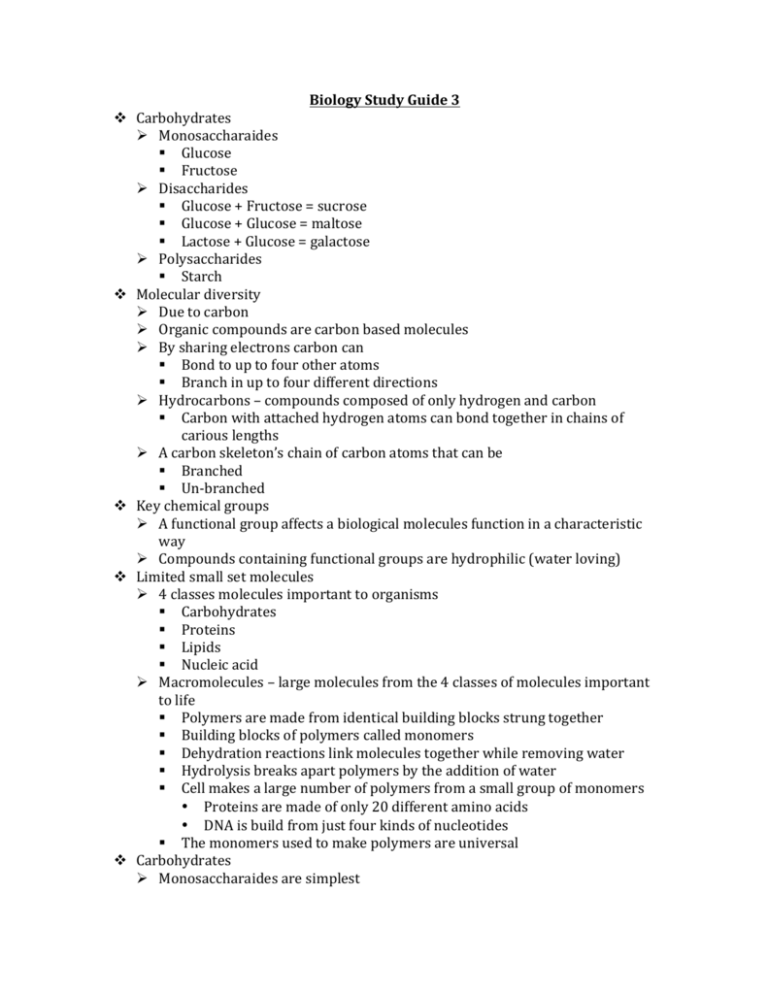
Biology Study Guide 3 v Carbohydrates Ø Monosaccharaides § Glucose § Fructose Ø Disaccharides § Glucose + Fructose = sucrose § Glucose + Glucose = maltose § Lactose + Glucose = galactose Ø Polysaccharides § Starch v Molecular diversity Ø Due to carbon Ø Organic compounds are carbon based molecules Ø By sharing electrons carbon can § Bond to up to four other atoms § Branch in up to four different directions Ø Hydrocarbons – compounds composed of only hydrogen and carbon § Carbon with attached hydrogen atoms can bond together in chains of carious lengths Ø A carbon skeleton’s chain of carbon atoms that can be § Branched § Un-­‐branched v Key chemical groups Ø A functional group affects a biological molecules function in a characteristic way Ø Compounds containing functional groups are hydrophilic (water loving) v Limited small set molecules Ø 4 classes molecules important to organisms § Carbohydrates § Proteins § Lipids § Nucleic acid Ø Macromolecules – large molecules from the 4 classes of molecules important to life § Polymers are made from identical building blocks strung together § Building blocks of polymers called monomers § Dehydration reactions link molecules together while removing water § Hydrolysis breaks apart polymers by the addition of water § Cell makes a large number of polymers from a small group of monomers • Proteins are made of only 20 different amino acids • DNA is build from just four kinds of nucleotides § The monomers used to make polymers are universal v Carbohydrates Ø Monosaccharaides are simplest Carbohydrates range from small sugar molecules (monomers) to large polysaccharides § Sugar monomers are monosaccharaides such as those found in honey • Glucose • Fructose § Monosaccharaides can be hooked together to form • More complex sugars • Polysaccharides Simple CHO Complex CHO Disaccharide Sugar Starch Maltose Monosaccharaide Polysaccharide Sucrose Glucose fructose galactose Cellulose – plant, cell wall, fiber, structure Glycogen – animals – short term energy storage Chitin – exoskeleton, structural Starch – short term energy storage in plants Monomer Polymer v High fructose corn syrup Ø Sodas/fruit drinks probably contain high fructose corn syrup (HFCS) Ø Fructose sweeter than glucose Ø To make HFCS glucose atoms are rearranges to make the glucose isomer fructose Ø HFCS is used § To sweeten many beverages § May be associated with weight gain Ø Good health promoted by § A diverse diet of proteins fats vitamins minerals and complex carbohydrates § Exercise v Polysaccharide Ø Chains sugar units Ø Polysaccharides usually hydrophilic Ø Bath towels § Often made of cotton which is mostly cellulose water absorbent v Lipids Ø Water insoluble (hydrophobic) compounds Ø Important in long term energy storage Ø Contain twice as much energy as a polysaccharide Ø Consist mainly of carbon and hydrogen atoms linked by non-­‐polar covalent bonds Ø Not huge molecules Ø Not built from monomers § Ø Vary a great deal in § Structure § Function Ø Steroids – testosterone – hormone – cholesterol Ø Phospholipids – cell membrane Ø Fat (triglycerol) – fat cells Ø A fat Is a large lipid made from two kinds of smaller molecules § Glycerol § Fatty acids Ø Fats Unsaturated Saturated Has double bonded carbons No double bonded carbons Every carbon does not have max # Has max # hydrogen’s per carbon hydrogen’s it can bond Liquid at room temperature Solid at room temperature v Phospholipids and steroids Ø Steroids are lipids in which the carbon skeleton contains four fused rings Ø Cholesterol is a § Common component in animal cell membranes § Starting material for making steroids including sex hormones v Anabolic steroids Ø Synthesis variants of testosterone Ø Can cause a build-­‐up of muscle and bone mass Ø Often prescribed to treat general anemia and some diseases that destroy body muscle Ø Abused by some athletes with serious consequences § Violent mood swings § Depression § Liver damage § Cancer § High cholesterol § High blood pressure v Phospholipids Ø Structurally similar to fat Ø The major component of all cells Ø Contain 2 fatty acids attached to the glycerol
